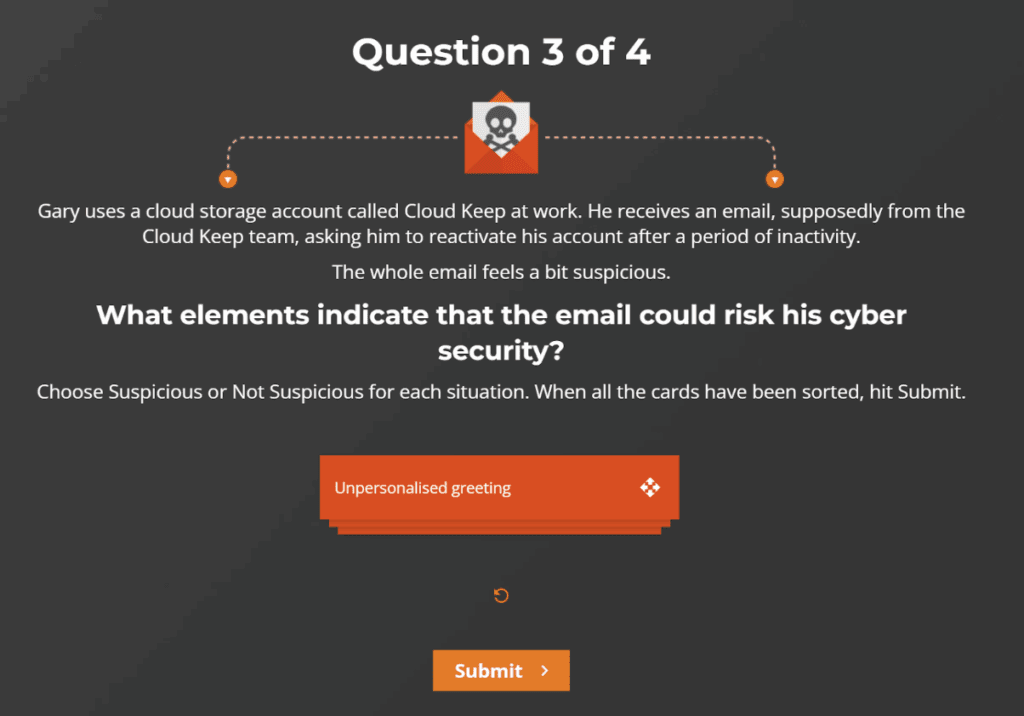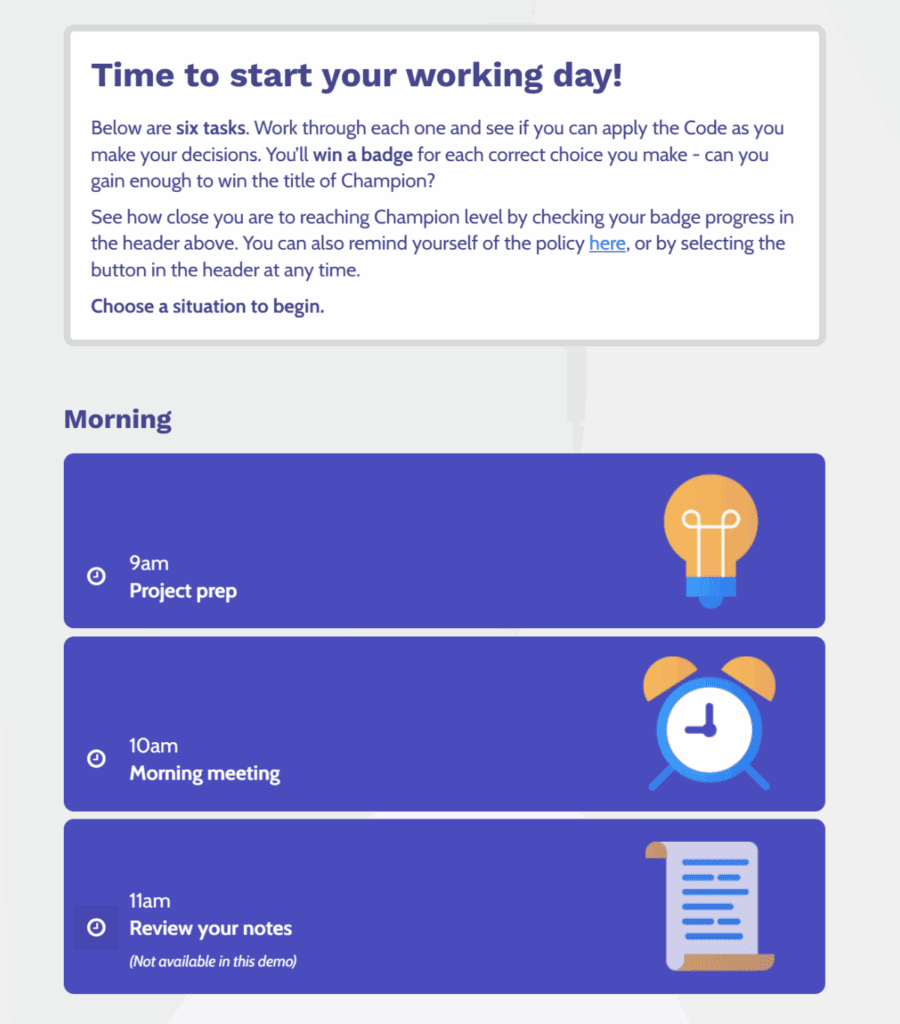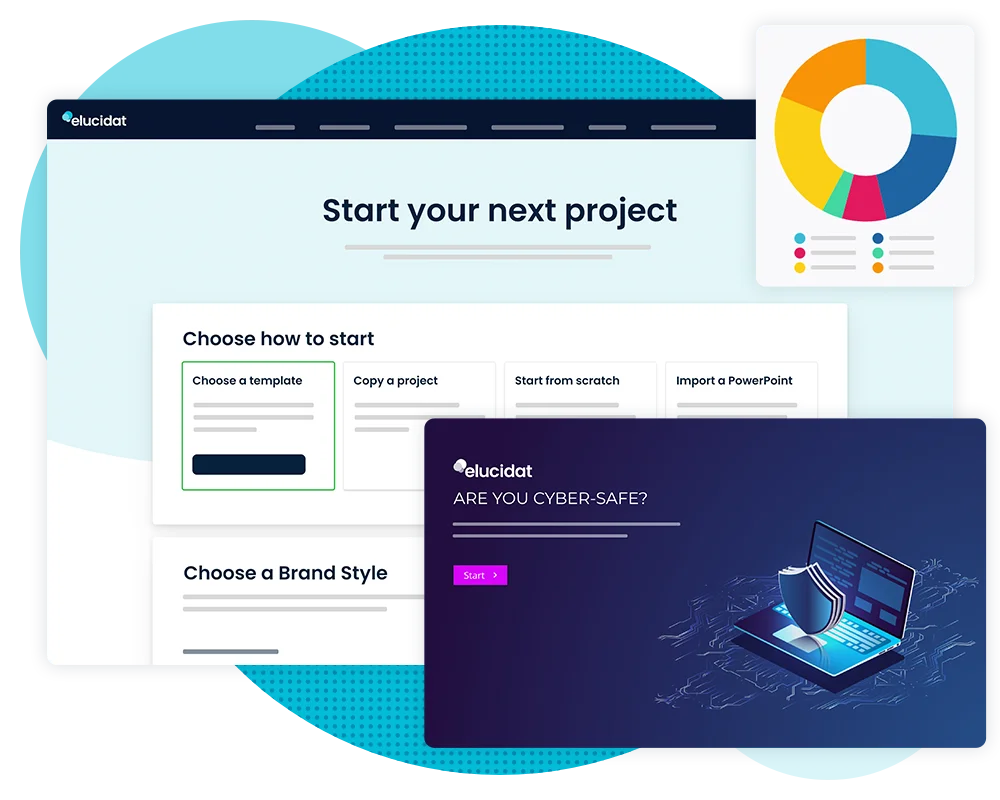Guide to designing compliance training that’s not boring
8 minute read
When you hear ‘compliance training’, what springs to mind? Chances are, it’s not words like inspiring, useful, or memorable. But that’s precisely what it should be. Whether it’s protecting you legally or saving lives, compliance is some of the highest-stakes content in your organization. Give it the attention it deserves with this guide to designing training that drives lasting behavioral change.

What is compliance training?
Anti-bribery. Diversity and inclusion. Data protection. These are some of the most common types of corporate compliance training. But compliance can be less run-of-the-mill, too. Think of oil rig safety or nuclear power plant inspections.
Here’s what it comes down to: compliance training gives people what they need to operate within certain rules.
These rules aren’t always laws. They can be guidelines set by regulators or even policies specific to your organization.
Ultimately, compliance training reduces your organization’s risk and fosters trust. It helps stop people from breaking the rules, so you won’t face the consequences.
Why is compliance training important?
The consequences of rule-breaking can be severe. Think reputation damage, serious fines, and even prison sentences. Just look at the Volkswagen emissions scandal or Facebook’s Cambridge Analytica fallout.
And let’s face it, following the rules is usually the right thing to do anyway.
But giving people a big list usually doesn’t cut it. Why not? Well, just think about the last policy document you read. Rules are typically written in legal language that’s almost impossible to understand. And they can feel pretty abstract, too.
Take this line from the EU’s GDPR regulation:
Organizations must report a personal data breach to the relevant supervisory authority within 72 hours of becoming aware of it.
Without expert knowledge, you might ask: What’s personal data? What’s a breach? What do I personally have to do if I spot one?
That’s where a compliance training plan comes in. It’s designed to help change people’s behavior so they make the right decisions in the real world.
Here’s how:
- Compliance training makes people stop and think about the right response in the moment. They’ll notice the data breach, instead of being oblivious to it.
- It prepares them to take action. Whether that’s mentioning the breach to their manager or following a formal process, they won’t just sit on their laurels.
- By explaining the principles behind the rules, it equips them to make decisions in nuanced situations. They’re confident about reporting the breach because they understand why it matters.
In short, compliance training is the difference between claiming you follow the rules and actually getting your people to do so. And with global regulations tightening, that matters now more than ever.
Examples of compliance training
There is no one-size-fits-all approach to compliance training. Different industries and roles face different risks. Let’s look closer at some popular topics for compliance training.
Health and safety
Also known as occupational safety, this training helps people follow rules that keep them safe and well. Topics can include emergency response, handling chemicals safely, and workstation ergonomics.
Diversity, equity, and inclusion
Rooted in equality law, this training helps people understand the rules and the values behind them. It equips learners to spot and avoid workplace discrimination and unfair treatment.
Data protection
As laws on handling data securely become stricter, data protection training is more important than ever. It covers what personal data is, how it can and can’t be used, and what to do if it’s shared by mistake.
Anti-bribery and corruption
In roles where bribery or corruption is possible, clear boundaries are essential. From what’s an acceptable gift to the consequences of crossing the line, this corporate compliance training makes the rules easy to understand.
Cybersecurity
With hacking and cyber threats rising, this training adds an extra layer of protection. Topics include spotting suspicious emails, setting strong passwords, and using devices securely.
Where compliance training fails
It all sounds pretty important and, dare we say, even interesting, right? So why do so many people glaze over at the very mention of compliance training?
‘Boring’, ‘uninspiring’, ‘tick-box exercise’…these are just a few of the complaints noted by the learning professionals we spoke to.
And, honestly, it’s no surprise. Corporate compliance training has earned its bad reputation from how it’s traditionally been delivered.
Those dry-as-dust policy documents? Picture them with a few token activities thrown in, popped in a SCORM wrapper, and labeled ‘online training’. Make it mandatory once a year, with a quiz at the end, and call it done. Employees go through the motions, but they’re not really learning.
Except it isn’t, of course. The training is just as confusing, theoretical, and impersonal as the original guidelines. There’s absolutely nothing there to actually change behavior.
To do that, you need to rethink your approach. Let’s look at how.
Practical strategies to create impactful compliance training for employees
Impactful compliance training starts with the right approach. Read on for practical strategies to help you build a compliance training program that improves workplace compliance.
Don’t skip the prep work
Once you know your training requirements, it’s tempting to jump into the training design process. But hold fire for just a moment. Because effective compliance training always begins with content preparation.
First, you must uncover the behavioral changes you need to see in learners. It’s one thing to say discrimination is illegal, but quite another to get a staff member to notice and respond to it correctly.
Work with subject matter experts to nail down exactly what learners must do to stay compliant. Gather lots of examples, including tricky ‘gray area’ situations where the answer’s not immediately clear. Ask if there’s anything blocking people from doing the right thing.
And think about the roles of your learners. Where are they located? What’s their experience? You need to make compliance training as relevant to them as possible. That might mean personalizing the content. Now’s the time to figure out who needs to learn what.
Here’s a quick summary of this:
1. Start with prep work – Don’t rush into training design, focus on content first.
2. Define desired behaviors – Identify how learners should act, not just what’s illegal.
3. Collaborate with experts – Gather clear actions, examples, and barriers to compliance.
4. Tailor for your audience – Consider learners’ roles, locations, and experience for relevant, personalized content.
5 ideas for effective compliance training
Once your content’s nailed down, it’s time to get creative. Try these five tried-and-tested ideas for creating compliance training that’s actually engaging.
1. Episodic storytelling
Who doesn’t love a good Netflix binge? Bring the same appeal to your audience with an episodic structure that gets attention.
Try splitting out content into story-driven scenarios, like helping a struggling colleague, and present them as episodes on a menu screen. In each one, learners make a decision, then see the consequences play out.
A bonus of episodes? The bite-sized format lets you easily tweak content for different roles and teams, so there’s something for everyone.
2. Immersive stories
Dive deeper with rich, detailed stories that reflect the complexity of real-life situations. Use multiple character perspectives to let learners explore the nuances they might encounter on the job.
For instance, you could present a scenario where it’s all gone wrong, then challenge the learner to investigate what’s happened. Along the way, they learn about the rules in a memorable, hands-on way.
3. Branched consequences
In the real world, getting compliance wrong can have serious repercussions. So why not give learners a safe space to practice?
Branching scenarios send learners down different paths depending on the decisions they make. It’s a risk-free way to see the cost of getting it wrong. Even better, this format gives you the option to tailor the experience with personalized content based on a learner’s specific knowledge gaps.
4. Moments of reflection
Compliance training isn’t a one-way street. Help learners connect the content to their own experiences by getting them to pause and reflect.
Try asking which aspect of the content resonates most. Or elicit more complex ideas by inviting them to free-type their thoughts. You could even collect this input to shape future training around what they find most challenging.
5. Social polls
A social poll asks the learner questions, then reveals how their peers answered. It’s especially effective in a compliance context because it creates a shared experience. People feel like they’re in it together.
It also taps into social accountability. No one wants to be the outlier making risky choices.
Best compliance training examples
Time to see it in action. Check out these examples of compliance training that are anything but snooze-worthy.
Branching scenario
Take a look at this anti-workplace bullying module. Combining an immersive story with branched consequences, the learner is dropped into the thick of a dramatic situation and must decide what to do next.

Personalized content
In this cybersecurity training, personalization is the name of the game. It opens with a scenario-based quiz designed to spot knowledge gaps, before serving up only the content that’s needed.

Social polling
This activity-led module on social media security asks learners to tap into their instincts around those all-too-familiar gray areas. Social polls show how others responded, before clearly laying out the right way to handle things.

Gamified compliance
This Code of Conduct training makes policy compliance a literal game. Using an episodic format, it challenges learners to apply the Code in a series of job-realistic activities, earning badges as they go.

Summary
Compliance training doesn’t have to be boring. When it’s designed with real people in mind, a compliance training program is effective, engaging, and downright inspiring. A simple rethink is all it takes to make it some of the most exciting training in your organization.
So what are you waiting for? Start your compliance training makeover today.
Need more ideas? Check out these compliance training strategies, explore more examples of it done right, and watch our webinar on designing for ethics and values.
Looking for the right tool to make it happen? Book a demo of Elucidat to see how it can transform your compliance training and drive lasting behavioral change.




